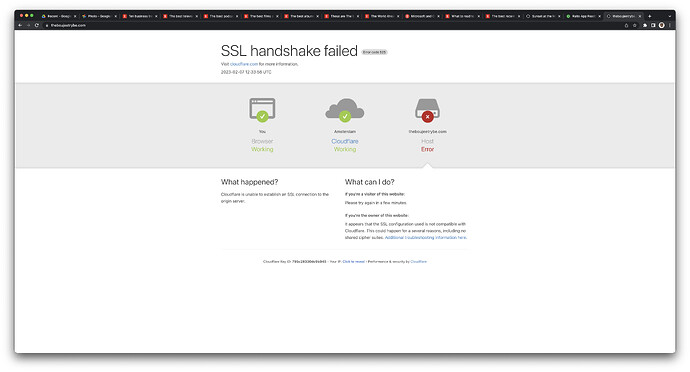Introduction
The SSL handshake is a crucial process that underpins secure communication on the internet. SSL (Secure Sockets Layer) ensures that data exchanged between a user’s browser and a website’s server remains encrypted, safeguarding sensitive information such as passwords, credit card details, and personal data. This handshake establishes a secure connection and verifies the identity of both parties.
However, when something goes wrong during this handshake, users may encounter the frustrating “SSL handshake failed error code 525”. This error indicates a failure in establishing a secure connection, typically due to communication issues between the browser, server, or content delivery network (CDN). Understanding and resolving this error is critical to maintaining the trust and security of your website.
What Causes the SSL Handshake Failed Error Code 525?
Several factors can lead to this error. The most common causes include:
- Server-Side Issues
Misconfigured servers or incorrect SSL settings can disrupt the handshake process, preventing secure communication. - Client-Side Misconfigurations
Browser settings, outdated software, or incompatible devices may fail to support the required SSL/TLS protocols. - TLS/SSL Protocol Mismatches
If the server and client are unable to agree on a mutual TLS/SSL protocol version or cipher suite, the handshake will fail. - Expired or Invalid SSL Certificates
An expired, revoked, or incorrectly installed SSL certificate on the server can trigger this error. - Firewall or CDN Misconfigurations
Improper settings in a content delivery network (like Cloudflare) or firewall blocking SSL traffic can also lead to error code 525.
Preliminary Checks Before Troubleshooting
Before diving into fixes, perform these preliminary checks to narrow down potential causes:
- Confirm the Website’s SSL Certificate Validity
Use tools like SSL Labs to verify the status of the website’s SSL certificate. Ensure it hasn’t expired or been revoked. - Check the Browser’s Compatibility
Ensure your browser is up to date and supports modern TLS versions. Compatibility issues can often be resolved with an update. - Inspect Server Logs for Errors
Server logs provide valuable insights into connection failures. Look for patterns or specific entries related to SSL or TLS.
With a clear understanding of the potential causes and preliminary checks completed, the next steps will focus on targeted fixes to resolve the issue.
How to Fix SSL Handshake Failed Error Code 525
When encountering the SSL handshake failed error code 525, troubleshooting requires addressing issues on both server and client sides. Below are detailed steps to resolve the problem, along with advanced techniques and preventive measures.
4.1 Verify and Update SSL Certificate
An invalid or expired SSL certificate is one of the most common culprits behind handshake failures.
- Steps to Renew or Replace a Certificate:
- Check the expiration date of your SSL certificate using online tools like SSL Labs.
- If the certificate has expired, obtain a new certificate from a trusted certificate authority (CA).
- Install the updated certificate on your server following the CA’s instructions.
- Validate the Certificate Chain:
Use tools like OpenSSL or SSL Checker to ensure that the certificate chain (root, intermediate, and end-entity) is complete.
4.2 Check Server-Side TLS Configuration
Misconfigured TLS settings can disrupt the handshake process.
- Ensure Compatibility with Modern TLS Protocols:
Configure your server to support modern TLS versions like TLS 1.2 and TLS 1.3. Older versions (e.g., SSL 3.0, TLS 1.0) should be disabled as they are deprecated and insecure. - How to Update Settings:
- For Apache: Modify the
ssl.confor.htaccessfile to include secure protocols and cipher suites. - For NGINX: Update the
ssl_protocolsdirective in the configuration file.
- For Apache: Modify the
4.3 Inspect and Configure Web Server Settings
Server misconfigurations can result in mismatched keys or certificates, causing handshake failures.
- Correct Private Key Mismatches:
Ensure that the private key installed on your server matches the public key in the SSL certificate. Use command-line tools like OpenSSL to verify the match. - Web Server-Specific Fixes:
- For Apache: Check
SSLCertificateKeyFileandSSLCertificateFiledirectives. - For NGINX: Ensure correct paths in the
ssl_certificateandssl_certificate_keydirectives.
- For Apache: Check
4.4 Firewall and CDN Settings
Firewalls or CDNs like Cloudflare often introduce misconfigurations that block SSL traffic.
- Check CDN SSL/TLS Settings:
- If using Cloudflare, navigate to the SSL/TLS settings in your Cloudflare dashboard.
- Ensure the SSL mode is set to “Full” or “Full (Strict)” for end-to-end encryption.
- Resolve Firewall Issues:
Adjust firewall rules to allow HTTPS traffic on port 443. Temporarily disable the firewall to confirm whether it’s causing the handshake failure.
4.5 Client-Side Solutions
While server-side fixes are common, issues on the client side can also contribute.
- Clear Browser Cache and Cookies:
Navigate to your browser’s settings to clear cached data and cookies that may interfere with SSL connections. - Disable Interfering Browser Extensions:
Test the connection in incognito mode or disable extensions like ad blockers that might disrupt the handshake. - Update the Client’s OS or Browser:
Ensure your browser and operating system support the latest TLS standards. Compatibility issues often stem from outdated software.
Advanced Troubleshooting Techniques
For persistent issues, delve deeper with these tools and methods:
- OpenSSL Commands: Test SSL/TLS connections and diagnose handshake errors using OpenSSL.
- SSL Labs Tests: Use the SSL Labs website to analyze server configurations and identify weaknesses.
- Wireshark or cURL: Debug handshake processes and inspect packets for anomalies.
Preventing SSL Handshake Failed Errors in the Future
Proactively maintaining your SSL/TLS configurations can prevent handshake failures:
- Regularly update your SSL certificate and monitor expiry dates using tools like Certbot or automated reminders.
- Audit server configurations periodically to ensure compatibility with modern TLS protocols.
- Use reliable tools for monitoring and managing updates on both server and client sides.
LEARN MORE: WonderFox HD Video Converter Factory Pro Review: Does It Really Work?
Conclusion
Fixing the SSL handshake failed error code 525 involves identifying and resolving server and client-side issues, such as expired SSL certificates, misconfigurations, or protocol mismatches. By following the steps outlined above and implementing regular maintenance practices, you can minimize future disruptions and maintain a secure online presence.



